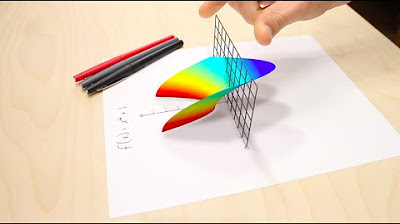APA ITU BILANGAN KOMPLEKS ? (Materi Kurikulum Merdeka)
Summary
TLDRThis video script delves into the concept of complex numbers, explaining their composition of real and imaginary parts. It distinguishes between rational and irrational numbers, and further breaks down real numbers into whole numbers, natural numbers, and negative numbers. The script explores the utility of imaginary numbers in solving equations with no real roots, such as x² + 1 = 0. It also introduces three representations of complex numbers: Cartesian form, polar form, and exponential form, providing examples and their geometric interpretations on the Cartesian plane. The explanation aims to clarify the nature and applications of complex numbers, offering viewers a comprehensive understanding of this mathematical domain.
Takeaways
- 😀 The video discusses the concept of complex numbers and their relationship with real and imaginary numbers.
- 🔍 Real numbers are divided into rational and irrational numbers, with rational numbers further categorized into fractions and whole numbers.
- 🌐 Imaginary numbers are defined as the square root of negative one, specifically \( \sqrt{-1} \).
- 📚 Complex numbers are a combination of real and imaginary numbers, forming a higher level of numbers.
- 🧩 The script explains that irrational numbers, like the square root of 5, cannot be simplified and are part of the real numbers.
- 📐 The concept of imaginary numbers is introduced through the solution of quadratic equations that have no real roots, such as \( x^2 + 1 = 0 \).
- 📈 There are three ways to represent complex numbers: Cartesian form, polar form, and exponential form.
- 📊 Cartesian form is represented as \( z = x + yi \) where \( x \) is the real part and \( y \) is the imaginary part.
- 🌀 Polar form is expressed as \( r(\cos \theta + i\sin \theta) \), where \( r \) is the magnitude of the complex number and \( \theta \) is the angle.
- 🌟 Exponential form uses the identity \( e^{i\theta} = \cos \theta + i\sin \theta \), making it equivalent to the polar form.
- 📚 The video encourages viewers to understand these concepts and provides examples of how complex numbers can be represented graphically on a Cartesian plane.
Q & A
What is a complex number?
-A complex number is a combination of a real number and an imaginary number.
What are the types of numbers mentioned in the script?
-The script mentions real numbers and imaginary numbers.
What is an imaginary number?
-An imaginary number is the square root of -1, represented as i.
How are real numbers categorized?
-Real numbers are categorized into rational and irrational numbers.
What are rational numbers further divided into?
-Rational numbers are further divided into fractions and whole numbers.
What is the Cartesian form of a complex number?
-The Cartesian form of a complex number is z = x + yi, where x and y are real numbers.
What does x represent in the Cartesian form of a complex number?
-In the Cartesian form, x represents the real part of the complex number.
What does y represent in the Cartesian form of a complex number?
-In the Cartesian form, y represents the imaginary part of the complex number.
How is a complex number represented in polar form?
-A complex number in polar form is represented as r(cos θ + i sin θ), where r is the magnitude and θ is the angle.
What is the exponential form of a complex number?
-The exponential form of a complex number is r * e^(iθ), where r is the magnitude and θ is the angle.
Outlines

This section is available to paid users only. Please upgrade to access this part.
Upgrade NowMindmap

This section is available to paid users only. Please upgrade to access this part.
Upgrade NowKeywords

This section is available to paid users only. Please upgrade to access this part.
Upgrade NowHighlights

This section is available to paid users only. Please upgrade to access this part.
Upgrade NowTranscripts

This section is available to paid users only. Please upgrade to access this part.
Upgrade NowBrowse More Related Video

Complex Numbers 01 | Introduction to Complex Numbers | Class 11 | JEE

kompleks 01 pendahuluan

FÁCIL e RÁPIDO | NÚMEROS COMPLEXOS

Imaginary Numbers Are Real [Part 1: Introduction]

LATIHAN A NO 1 2 3 BILANGAN KOMPLEKS MATEMATIKA TINGKAT LANJUT SMA KELAS 11 #kurikulummerdeka

Numbers in Python Version 2 || Python Tutorial || Learn Python Programming
5.0 / 5 (0 votes)